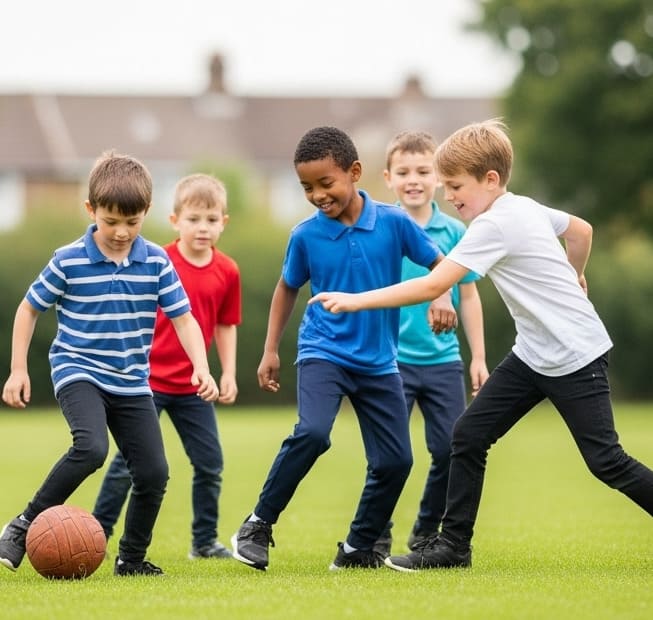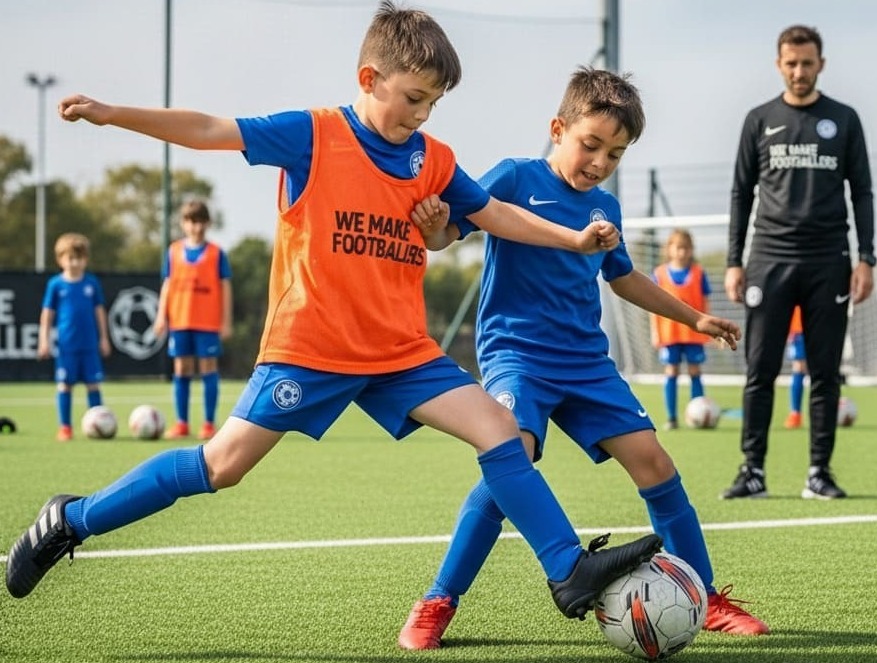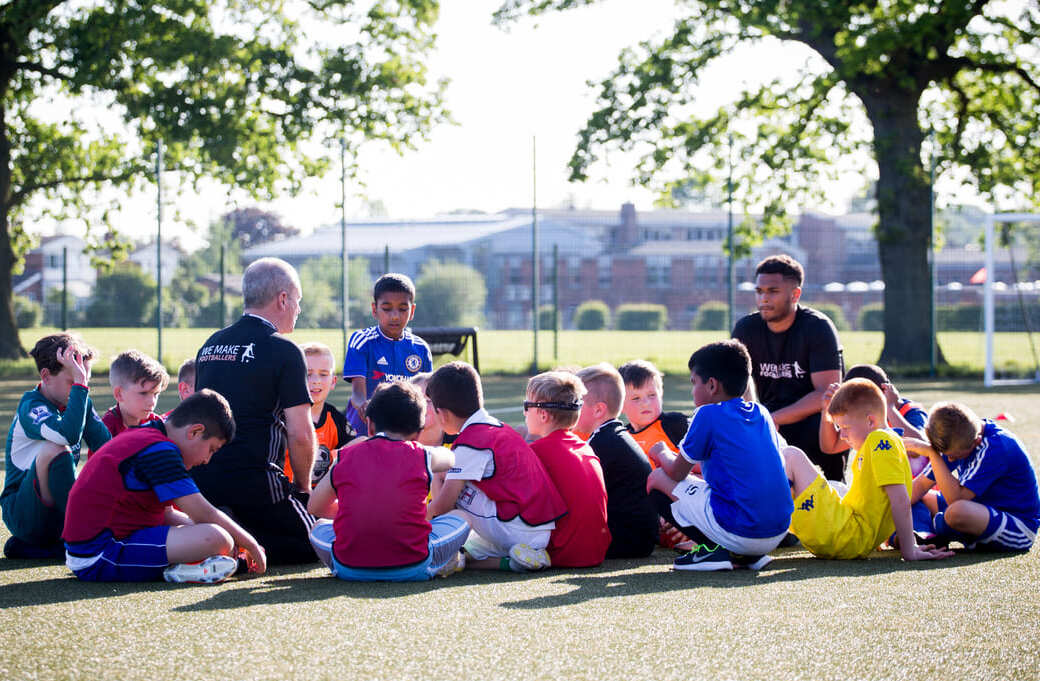Injury is an unfortunate yet often inevitable part of youth football. The odds are that every child will sometimes suffer an injury that rules them out of playing the sport. Football is after all a contact sport and not without risk.
One of the youth football coach's primary aims is to limit the prospect of injuries happening as much as possible. This can be done by showing children the importance of warming up and introducing other good habits into their football routine, such as teaching proper tackling.
Teaching a child safe techniques for tackling can reduce the chances of them injuring themselves or other children. Good coaches will also recognise when burnout is occurring and give children the rest and recovery they need by reducing their workload.
Usually, it is overplaying which causes injury to children by placing too much strain on young muscles which are still developing. It turns out too much of a good thing – playing football – can be bad for you.
As important as injury prevention is helping a child recover and overcome the problem. Children who suffer from even short-term injuries can experience a range of emotions, from pain to fear to anger and sorrow that they are missing out on playing football.
The more that a parent can do to support a child through an injury, the quicker and stronger their comeback can be. Here is how to help a child recover and overcome an injury.
Diagnose the problem
Diagnosing the problem is the first step toward informing the recovery process. The most common football injuries suffered tend to be muscle strains to the groin, calf, hamstring or quad – the major muscles used by the leg when kicking a ball.
Sprained ankles are also commonplace, especially when football takes place on uneven grass surfaces during the summer months. An ankle which rolls inwards or outwards can lead to the ligaments being overstretched, causing the joint to be destabilised.
Examples of more severe injuries could be those to anterior cruciate ligaments. The ACL is in the knee and is commonly injured when the upper leg goes in a different direction to the lower leg. ACL injuries vary; a full tear would likely require surgery whilst a sprain can be managed with physiotherapy.
Speaking to your child’s football coach can help shed some light on the problem as they will have experienced most injuries before. If the injury remains a mystery or is more serious than something which can be treated at home – such as an ACL or broken bones – then you should seek professional medical advice for the diagnosis, either from a physio or a doctor.
Take the right steps towards recovering from injury
For muscle strains and sprained ankles, treatment can begin right away following the POLICE and HARM principles of recovery. POLICE provide the procedure for treatment whilst HARM is what should be avoided to prevent doing further damage.
-
Protect: The injury should be rested in the immediate aftermath. Whilst this happens, it also needs to be protected with some form of support or splint.
-
Optimal Loading: One common misconception about leg muscle and ankle injuries is that they should be rested completely until the pain is gone. Gentle activity is actually better sooner rather than later. Gradually putting weight on an injury guided by what feels right builds up a range of movement and helps the body avoid becoming accustomed to idleness.
-
Ice: Cold compressing the injury improves blood flow to the area, introducing more oxygen to speed up recovery. Anything from an ice compression pack to a bag of frozen peas wrapped in a towel can help, applied every 20 minutes, every couple of hours for the first two to three days.
-
Compression: Wrap a bandage or other medical aid around the injured area to help reduce swelling.
- Elevate: Elevate the injured leg above the level of the heart whilst resting, using a cushion and a chair. Arm injuries can be put in a sling to lift them.
For the first few days after injury, avoid the following to prevent doing more HARM. That should make this one an easy acronym to remember.
-
Heat: Putting heat on injuries was once considered good practice. Not anymore. Avoid heat packs, hot baths and showers.
-
Alcohol: Alcohol impacts on recovery rate and increases the chances of getting reinjured. Not that beer, wine and spirits should be hampering a child’s recovery from injury. So perhaps one to remember if you are an injured adult?
-
Running: Avoid moderate activity as this can cause further damage. The most enthusiastic children will want to dive straight back in. It is vital they do not.
-
Massage: Massages can help loosen tight muscles but they are a treatment for further down the line. When an injury is fresh, a massage can increase swelling and bruising and so should be avoided for the first few days.

Lay out a timetable for return
Uncertainty is one of the biggest issues which come with injuries in youth football. Diagnosis of the problem removes one level of uncertainty and another can be alleviated by producing a timetable for return.
Grade I muscle strains – the less serious - typically take between three and six weeks to recover from. A sprained ankle will start feeling better after two weeks but can take up to eight weeks before the full strenuous activity takes place without pain.
Marking milestone dates on a calendar for a child’s return from injury gives them lightly at the end of the tunnel. When they see that they will be able to resume light training in two weeks followed by full training a fortnight later, it provides motivation and structure.
Clearly, there needs to be a degree of flexibility to any timetable. Plans can be slowed down if the injury is not healing as quickly as first hoped. They could even be accelerated if a child recovers faster than anticipated, although claims that they are should perhaps be taken with a pinch of salt if they are desperate to get back out on the pitch…
Encourage honesty and understanding of the importance of rest
One of the biggest weapons in fighting injury is honesty. The body will tell you when it is ready to return and to ignore it is to risk coming back too early and causing further damage. In youth football, that can translate to children saying they feel no pain and are fully recovered because they do not want to miss out when they are still experiencing discomfort.
Injury presents the opportunity for a child to understand more about their body and how it recovers from injury. Encouraging them to listen to it and trust it is not only valuable in terms of their comeback from their current injury; it teaches them a lesson that will stand them in good stead for future injuries.
It also places emphasis on the value of the rest. A super-active child may be totally aghast at the idea of resting. Yet downtime and recovery are important considerations built into the training schedules of professional and amateur athletes in every sport across the world. The difference that good rest can make in recovering from injury offers the chance for a child to experience this first-hand.
The importance of emotional support for an injured child
Children can be deeply impacted by injury striking and denying them the chance of taking part in something they love. This is especially true if it is the first time they have experienced an injury. It can be a daunting prospect and as important as helping them recover physically is offering emotional support.
Encouraging your child to share their thoughts and frustrations can help a parent to understand how much of an impact injury is having. It also shows them that they are not alone; that there are adults who are interested in their current situation and who are doing all they can to help them return to football.
One of the worst feelings a player can experience whilst injured in the sense that they have been forgotten by teammates and coaches, that they are no longer a part of the team. This is why our We Make Footballers coaches will always take the time to check in with injured players, find out how they are recovering and them know that they are still in the thoughts of their academy.
Teaching fundamental football skills extends to youth players missing through injury and making sure that they still feel involved ahead of their return, which our FA Qualified coaches will also carefully manage.
Reassure them that the worst will pass and there is a future after injury
“Things will get better” is a phrase that you probably tell your kids – and yourself – on a frequent basis across all walks of life. It is especially important and especially true when it comes to injury though, as injury can take even the most experienced of athletes into a dark place where the prospects of recovery seem slim.
Offering reassurance throughout the recovery process is therefore one of the biggest roles that a parent can play. Even the most serious of sports injuries are treatable in the 21st century, making it rare for football players to have to call time on their careers due to problems.
Roy Keane recovered from a terrible ACL tear to win the treble with Manchester United a year later. The great Francesco Totti made it back from a broken left leg to become a World Cup winner with Italy in 2006.
Petr Cech fractured his skull and was still able to continue playing. Santi Carzola seemed to endure a serious injury every season, at one point being ruled out for 18 months and needing eight ankle surgeries to repair an Achilles tendon problem.
Ruud van Nistelrooy ruptured his right ACL just before he was due to sign for United. His arrival at Old Trafford was delayed by a year as a result, although it had little impact on his goalscoring ability as he still plundered goals galore for United and later Real Madrid.
And then there is Xavi. One of the greatest footballers of all time tore his ACL in 2006. The 25-year-old was a player of rich promise at the time and there were fears that he might not play again. By 2009, he was the beating heart of Barcelona and Spain sides who would go on to dominate European and world football in a way no teams in history ever had.
Just like that impressive list of once-injured football players, your child will recover and get back in the game. Right now, it is a few missed weeks or months of football. They still have a lifetime of it ahead.
We Make Footballers are the largest football training academy for children aged between 4 and 12 in England. Weekly sessions are held for youth football players of all abilities by FA Qualified coaches in a fun and safe environment.
To find your nearest We Make Footballers Academy and book a free trial session, please see the We Make Footballers website.



